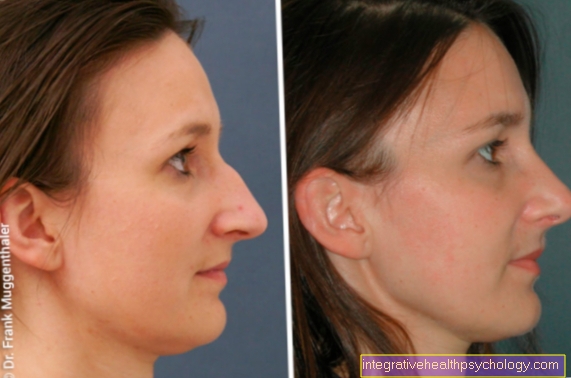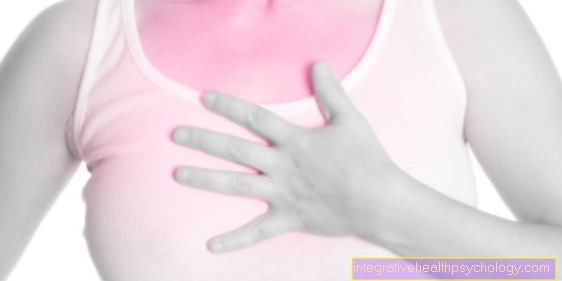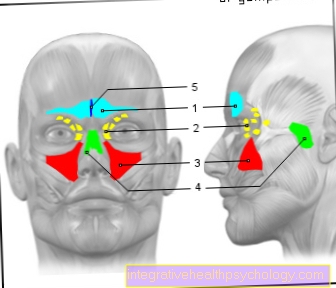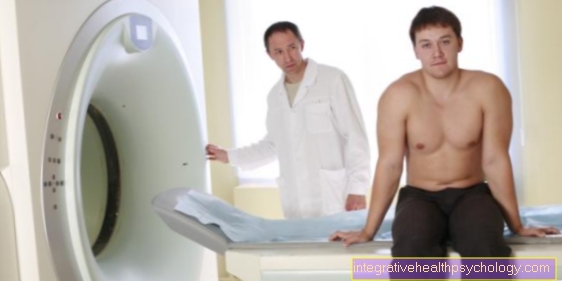Symptoms of hepatitis B
Symptoms of hepatitis B infection
The hepatitis B virus itself does not have any cell-destroying (cytopathogenic) properties. It is the immune reaction that is directed against the liver cells infected by the virus and destroys them. The course / symptoms of hepatitis B disease cannot be foreseen and can appear in all forms.
In 90% of patients with a hepatitis B virus infection, the liver cell inflammation heals spontaneously without consequences. About two thirds of these sufferers show the clinical symptoms of acute viral hepatitis, the rest of those affected, especially children, go through the disease without symptoms. These people thus represent a hidden source of infection and can infect others unnoticed.
Read more on this topic: Transmission of hepatitis B

The time between infection with hepatitis B and the onset of the first symptoms (incubation period) can be 2 weeks to 6 months.
In acute viral hepatitis, the patient initially complains of unspecific general symptoms such as:
- fatigue
- Fatigue,
- Loss of appetite
- nausea
- Vomit
- a headache
- Muscle and joint problems, possibly
- light fever.
Symptom feeling of pressure in the right overuse / costal arch
A feeling of pressure in the right upper abdomen can also occur as a symptom of hepatitis B. Both in the acute and in the chronic form. The liver is located in the right upper abdomen and is there - with normal size - hidden under the costal arch. If the liver is enlarged, it can reach far below the costal arch. Hepatitis can cause mild pain or pressure in the liver area. The symptom of a feeling of pressure in the right upper abdomen can be caused by an enlarged liver with water retention in the liver (Liver edema), and be caused by the associated organ capsule tension.
You might also be interested in this topic: Upper abdominal pain on the right side
Symptom of jaundice
Jaundice (Jaundice) and their accompanying symptoms arise. Jaundice is a typical symptom of acute hepatitis B, but only occurs in about 1/3 of infected people. The Billirubin (Bile pigment) can from the affected liver cells (Hepatocytes) are no longer excreted in the bile ducts. As a rule, jaundice only occurs after flu-like symptoms such as aching limbs, listlessness, nausea and vomiting have occurred. A typical symptom complex of jaundice develops.
This complex includes one:
- Yellowing of the skin and the
- Sclera (the whites of the eyes, dermis),
which are the most striking and obvious symptoms of jaundice. An excruciating itching as a result of deposited bile salts in the skin is particularly agonizing for the patient.
There are also symptoms such as clay-like discoloration of the stool (Acholia), due to the lack of bile pigments in the stool and a dark color of the urine, as the kidneys take over the excretion of the bile pigments. The lack of bile acids in the small intestine makes it harder to digest fats, which can lead to intolerance to high-fat meals and fatty stools (steatorrhea). The jaundice will go away completely after a few weeks.
Read more on the topic: Jaundice
Symptom loss of performance / fatigue
About 2/3 of all infected people notice the disease through various symptoms. One of the typical symptoms is a significant decrease in performance. The patients feel permanently tired and exhausted. Everyday activities are more difficult than usual due to the significantly increased fatigue. These symptoms last for days to weeks during the acute infection and usually disappear again completely.
Symptom fever
Fever is a symptom that can occur in numerous infectious diseases and also in inflammatory reactions of a non-infectious nature. It is therefore very unspecific and does not allow any more precise or reliable conclusions to be drawn about the triggering cause / disease. Fever can occur in acute hepatitis B. Usually this is a mild fever that rarely rises above 40 ° C.
Symptom joint and muscle pain
Joint, limb and muscle pains occur with common infections such as simple flu, but also with severe infectious diseases such as hepatitis B. In the acute form of hepatitis B, joint, limb and muscle pain are a relatively common symptom. However, since the complaints are very unspecific, they do not provide a reliable indication of the causal disease. The joint and muscle pain can also recur (recurring) in the context of chronic hepatitis B.
When do the symptoms appear?
The incubation period of hepatitis B, i.e. the time that elapses between infection and the appearance of the first symptoms, is between 45 and 180 days. About 1/3 of those infected do not experience any symptoms. The other 2/3 have flu-like symptoms on average after 60 to 120 days. One to two weeks later, jaundice can follow.
Liver failure
In rare individual cases (approx. 1%) life-threatening fulminant liver destruction with liver failure (see also function of the liver) can occur, so that it is not uncommon for those affected to only be helped by a liver transplant.
Chronic hepatitis B
In approx. 10% of the cases there is persistence (chronic course of hepatitis B infection) of the virus, and the often unsuspecting patient often becomes an asymptomatic carrier of the virus (so-called excretor). One speaks of chronic hepatitis B if the symptoms and / or the corresponding viral markers persist for 6 months. The chronification rate of the infected increases with decreasing age and is particularly high in newborns (approx. 90%). This chronic state of infection of the liver sooner or later leads to cirrhosis of the liver (connective tissue remodeling of the liver / loss of liver functions).
In principle, with a chronic hepatitis B virus infection there is also a significantly increased risk of developing liver cell carcinoma (hepatocellular carcinoma). Existing liver cirrhosis increases this risk even more.
An important co-factor in the development of liver cirrhosis and liver cancer is a simultaneous dependence on alcohol (alcohol abuse) in the patient and a second infection with the hepatitis C and D virus.
Typical symptoms of the chronic form
The chronic form of hepatitis B, like the acute form, is often asymptomatic. However, it can also cause discomfort. These possible symptoms include, for example, a feeling of pressure in the right upper abdomen, muscle, limb and joint pain, as well as fatigue and loss of appetite. One of the main complications of chronic hepatitis B is the development of cirrhosis of the liver. If such liver cirrhosis develops, it can be accompanied by numerous other symptoms. At first, however, liver cirrhosis is asymptomatic in most cases. Only in advanced stages (Child-Pugh stage B and C) do symptoms such as water retention (Edema), Water belly (Ascites) and liver skin signs such as Spider naevi, veins on the skin, or a palmar erythema, a flat reddening on the inside of the hands. With advanced liver cirrhosis, many patients develop varicose veins in the esophagus (Esophageal varices). These continue to grow in size and can burst at some point and then lead to profuse bleeding. Such bleeding can lead to blood vomiting and circulatory instability; rapid therapy is required. In the advanced stages of liver cirrhosis, an increasing failure of the detoxification functions of the liver can lead to impaired consciousness, which is called hepatic encephalopathy. Liver cirrhosis in an advanced stage means a significantly reduced life expectancy.
You might also be interested in this topic: Symptoms of cirrhosis of the liver
All possible symptoms of acute hepatitis B.
- Loss of appetite
- Exhaustion
- Reduction in performance
- fever
- Limb and joint pain
- nausea
- Vomit
- Jaundice
- Urine dark in color
- Light color of the stool
- Upper abdominal pain
All possible symptoms of chronic hepatitis B.
- fatigue
- Drive reduction
- Loss of appetite
- Muscle and joint pain
- Sensation of pressure in the right upper abdomen
- if cirrhosis of the liver develops, there are other possible symptoms:
- Bleeding in the esophagus with vomiting of blood
- Ascites
- Disturbances in consciousness in severe liver cirrhosis (hepatic encephalopathy)
- Water retention (edema)
- Skin symptoms such as:
- bluish discoloration in the area of the abdominal wall (caput medusae)
- Spider naevi
- Reddening of the palm of the hand (palmar erythema)
- Lacquer tongue

























-de-quervain.jpg)



